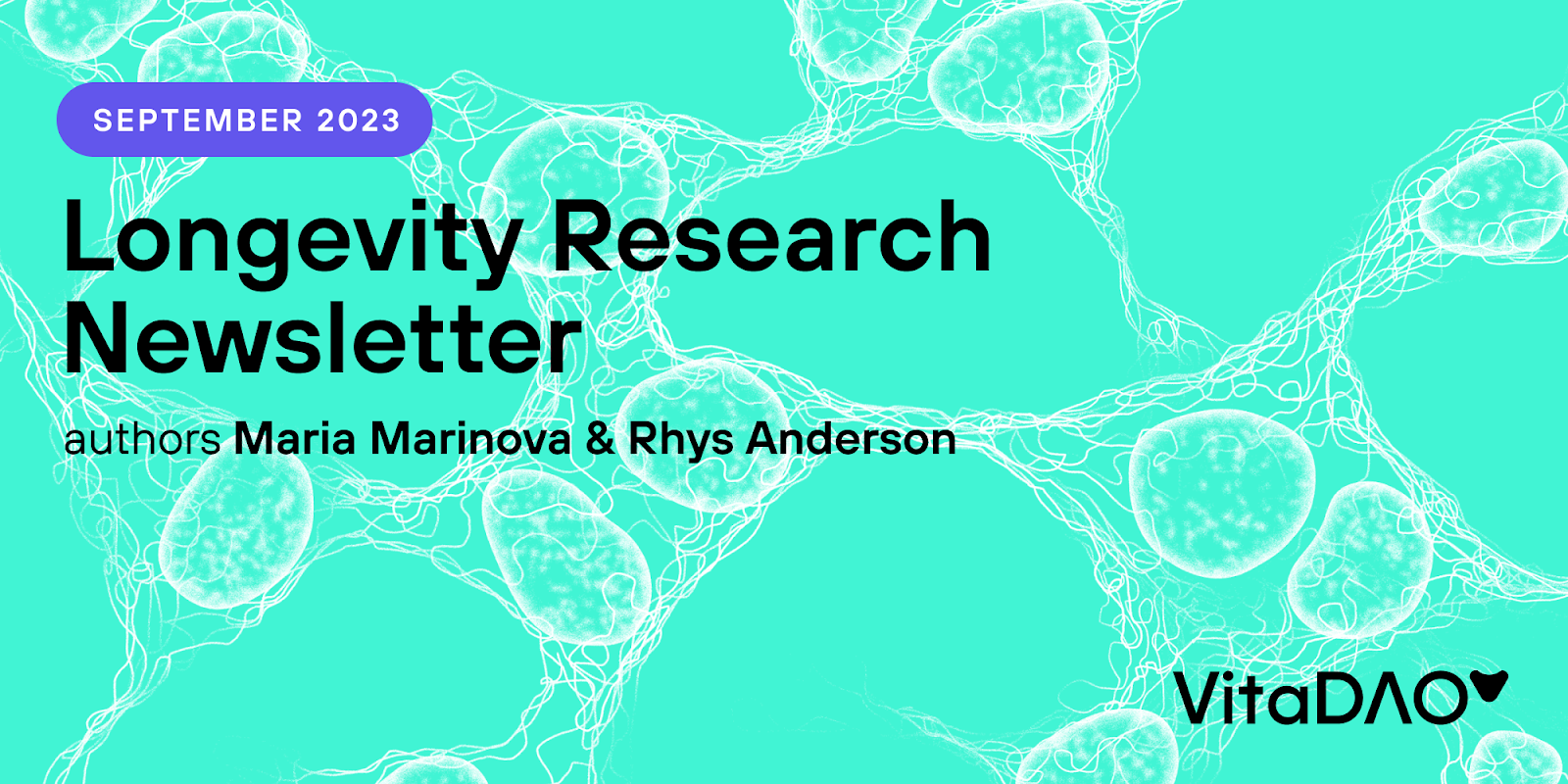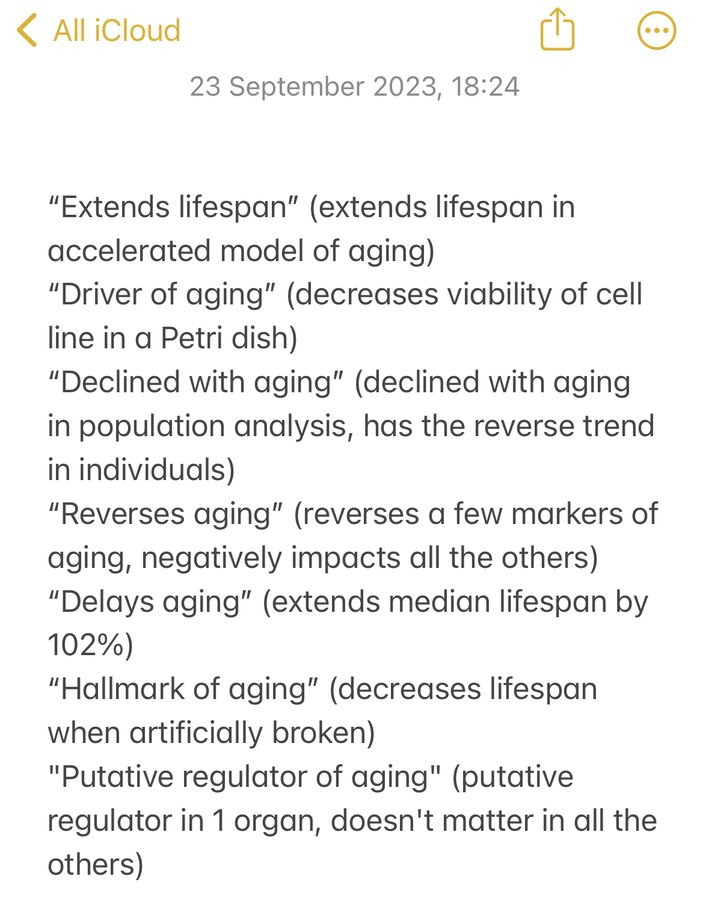
September Longevity Research Newsletter


Introduction
Welcome back Vitalians, it’s a big week for VitaDAO as we’ve just become the first DAO to kickstart a biotech company, MatrixBio. MatrixBio explores hyaluronic acid-based compounds, aiming to pioneer in cancer and aging treatments, utilizing insights from cancer-resistant naked mole rats in collaboration with Prof Vera Gorbunova.
Other exciting news: we have a new portfolio company. Please join us in congratulating the GERO team for passing the VitaDAO token holder vote with 99.98% voting in favour! This proposal was an assessment of a Machine Learning Platform for Age-Related Disease Targeting & Drug Discovery, with a view to creating therapeutics to slow down human aging and eliminate root causes of age-related diseases.

If you haven't already, please consider signing the Dublin Longevity Declaration.
We currently invest large sums of money trying to cure the leading causes of death such as heart disease, cancer and neurodegeneration, however the most common risk factor for all of these is age.
"For millennia, the consensus of the general public has been that aging is inevitable."
However, the last few decades of research has shown that aging isn't an immutable phenomenon, rather it is something that can be understood and targeted.
The Dublin Longevity Declaration is a consensus recommendation - already signed by a large number of leading figures in the aging field - to immediately expand research on extending healthy human lifespans.
Researchers are constantly exploring numerous avenues to rejuvenate organisms to younger healthier states, from epigenetic reprogramming, to stem cell therapies. This month we are excited to bring you an interview with a pioneer in the space, Professor Irina Conboy, who has made numerous contributions to the rejuvenation biology field, including the discovery of the rejuvenating effects of young blood through parabiosis. In this issue we’re going to delve deeper into her latest publication highlighted in our Hot Picks. To explore the topic further we are hosting a journal club with Irina and Michael Conboy on fail-testing DNA methylation clocks and developing a “noise” barometer for measuring epigenetic pressure - Oct 16th, 6 pm CET. Enjoy and we hope to see you there!
Longevity Literature Hot Picks

Preprint Corner
We have now entered Q4, but you still have until Friday 13th October to nominate great longevity preprints from Q3 2023 to be featured in the next issue of The Longevist! You can now nominate preprints using our new snazzy form and receive a bounty of 50 VITA for each one that makes the editors' shortlist or 200 VITA if it makes the curators' top 3.
And if you haven’t already seen it, here is our second issue of The Longevist, featuring the best longevity preprints from Q2 2023.

Check out our last batch of preprints of Q3 with these September submissions. These will each be entered into the Q3 longlist to be in the running to receive a coveted place in The Longevist. They are also available to review on our reviewing platform The Longevity Decentralized Review (TLDR) for a bounty of 50 VITA per review.
Methylglyoxal Affects Translation Fidelity
A pre-print by the 2nd palace winner of the Longevity Prize Rakhan Aimbetov expands on the topic of his submission. We love to see our initiative leading to tangible results, publications and research… If you want a lighter read on the topic we just published a Sci Comms article based on the topic of his prize entry: Sugar Byproducts and How They May Influence Aging
Tardigrades dramatically upregulate DNA repair pathway genes in response to ionizing radiation
Longevity interventions in Titan mice attenuate frailty and senescence accumulation
Hemin decreases cellular aging and enhances healthspan and lifespan through the AMPK pathway
B Cells Promote T Cell Immunosenescence and Mammalian Aging Parameters
Genetic architecture of telomere length in 462,675 UK Biobank whole genome sequences
Stability of Genomic Imprinting and X-Chromosome Inactivation in the Aging Brain
Cellular aging is accelerated in the malignant clone of myeloproliferative neoplasms
Published Research Papers

Elastic Net DNA methylation clocks show low prediction accuracy for age and health. The study suggests that stable cytosine methylation over lifespan indicates biological age. Dysregulated cytosines, measured as standard deviations, act as a "noise barometer" for aging and disease.

X-irradiation induces senescence in human corneal surface cells, leading to disruptions in the epithelial barrier, and in aging mice, the accumulation of senescent ocular cells contributes to chronic inflammation and barrier decline, suggesting these senescent cells could be a therapeutic target to treat aged ocular surface issues.
Association of biological age with health outcomes and its modifiable factors
Using the UK Biobank data, a multi-dimensional biological age model was developed. Accelerated aging correlates with health risks. 35 modifiable factors affecting aging were identified, notably pulmonary functions and body mass.
The fruit fly acetyltransferase chameau promotes starvation resilience at the expense of longevity
A mutation in Drosophila's "chameau" gene extends lifespan but reduces weight and starvation resistance. Despite its longevity benefits, poor nutrient stress handling likely keeps this mutation from being evolutionarily dominant.
And the press release: Sometimes beneficial, sometimes damaging: The double role of the enzyme chameau
Intact mitochondrial function in the setting of telomere-induced senescence
Mitochondria are crucial for cell health. This study explored the impact of telomere issues on mitochondria. By deleting the TRF2 protein, cell aging was induced, but mitochondrial function remained strong. Thus, even with telomere problems, mitochondria can support cell processes.
In a study of over 13,500 participants, certain plasma metabolites were linked to mortality and longevity. Elevated levels of metabolites like N2,N2-dimethylguanosine indicate higher mortality, while others like L-serine suggest increased longevity. The study implies specific metabolites can predict mortality, but the exact mechanisms remain undetermined.
Leveraging the secretory machinery to eliminate senescent cells
Senescent cells, which increase with age, contribute to tissue deterioration. A genomic screen showed that targeting the secretory actions of these cells in older mice can eliminate them. Suppressing the YAP–TEAD complex and reducing endoplasmic reticulum activity makes senescent cells more prone to apoptosis (cell death).
Death-seq identifies regulators of cell death and senolytic therapies

"Death-seq" is a new CRISPR screen designed to identify cell death mechanisms. It enhances cell death research, pinpointing enhancers for the senolytic ABT-263 and uncovering new inducers using ABT-199. This method reveals insights into cell death pathways and potential drug targets for conditions like senescence, cancer, and fibrosis.
Transcriptional and epigenetic decoding of the microglial aging process
Researchers studied aging effects on microglia, the brain's immune cells. Using mice, they found significant age-related changes, including unexpected sex differences. By creating a model to accelerate microglial aging, they discovered that aged microglia alone can cause cognitive decline, highlighting their role in brain function over time.
Pleiotropic influence of DNA methylation QTLs on physiological and ageing traits
Researchers identified a locus, meQTL.5a, in BXD mouse strains that influences DNA methylation patterns. This locus, combined with aging, results in an "aged methylome" for certain strains. It's linked to gene traits, body weight, lipid levels, and lifespan.
Complete or Culprit-Only PCI in Older Patients with Myocardial Infarction
A NEJM study of 1445 older patients with myocardial infarction and multivessel disease, complete revascularization resulted in fewer adverse events at 1 year compared to only treating the culprit lesion. Primary outcomes occurred in 15.7% of the complete-revascularization group versus 21.0% in the culprit-only group.
Published Literature Reviews, Hypotheses, Perspectives and more
We need to shift the focus of aging research to aging itself
Mitochondrial degradation: Mitophagy and beyond
Senescent cells at the crossroads of aging, disease, and tissue homeostasis
Biomarkers of aging for the identification and evaluation of longevity interventions
Quercetin and dasatinib, two powerful senolytics in age-related cardiovascular disease
Job board

Alexandra Stolzing at Loughborough University is looking for a Research Associate on a project about volatilome-based signature for age-related recovery & resilience.
The Valenzano lab at the Leibniz Institute on Aging in beautiful Jena, Germany, is looking for two postdocs (microbiome and pop-gen) and a master student.
David Vilchez has an open position for a lab technician/research assistant in his lab. It would be appreciated if the candidates have a good German level.
The HealthyLongevity.clinic in Florida is looking for a healthcare specialist.
News and Media

A new longevity fund lead by Alex Colville and Laura Deming has launched age1 to support new breakthrough longevity companies to address the field’s core challenges. A bit more from the co-founder and partner Laura: A Letter from Laura Daming
The Economist is finally catching up to the Longevist and has dedicated an entire issue with 8 articles to social and economic aspects of aging: In search of forever
- Slowing human ageing is now the subject of serious research
- Eating fewer calories can ward off ageing
- Ageing bodies need to get rid of decrepit cells
- Alternatives to the laboratory mouse
- Older genomes have more dodgy genes
- Fighting ageing requires properly equipped cells
- What the young can give to the old
- Some claim human lifespans can be lengthened indefinitely
The Economist Intelligence Unit also released: AGEING SHIFT
They introduce the "Scaling Healthy ageing, Inclusive environments and Financial security Today" (SHIFT) Index which benchmarks against a set of national-level leading practices to enable an environment that nurtures longevity and healthy ageing in 19 countries comprising the Group of Twenty (G20).
Featured topics:
- Demystifying ageing. Lifting the burden of fragility fractures and osteoporosis in Asia-Pacific
- iAgeing with strength. Addressing fragility fractures in Asia-Pacific
- The cost of silence: Cardiovascular disease in Asia
- The cost of inaction: Secondary prevention of cardiovascular disease in Asia-Pacific
- Covid-19: the greatest burden will fall on older people in low- and middle-income countries
- Global healthy ageing challenges: The need for transformation
- Healthy budgets and healthy people: Finance ministry views on the importance, strengths and limitations of tobacco tax revenue and its uses
Longevity is making it big in the mainstream media this month with another article about Bryan Johnson in Time magazine:
The Man Who Thinks He Can Live Forever
Another mention in Forbes magazine - an article by Alex Zhavoronkov with some specific definitions to distinguish Longevity Biotech companies and a checklist with criteria:
What Is A Longevity Biotechnology Company?
Actually we have one! Read more about the MatrixBio launch:
Pfizer-backed DAO launches community-funded biotech firm
Gulf Sovereign Fund, Hedge Fund Tycoons Bankroll Biotech to Fight Aging
Rejuveron closes a $75 million series B round
A longevity expert shares his exercise routine that he says was inspired by centenarians
The boom of the anti-aging market: How to get people to live to be 120 (and in good health)
If you’re up for some lighter reading here is a humorous piece by the New Yorker: Anti-Aging Secrets of the Mega-Rich
Live to 100? How about 1,000? Why this scientist believes we will one day have lifespans that long
New Epigenetic Clocks May Confirm Extreme Age
A race against time: How science and technology are being used to delay aging
What is the Blue Zones diet blowing up on Netflix? People who live to 100 eat this way
Resources

Longevity Summit Dublin has uploaded some fantastic talks to YouTube
Our favourites are:
The Million Molecule Challenge for Life Extension by Matt Kaeberlein
Dysregulation of Homeostasis Drives Human Aging by Peter Fedichev
Robust New Measures of Biological Age by Steve Horvath
And of course our very own:
Accelerating Research with Decentralised Science - Eleanor Davies
Longevity Network States – Max Unfried
Human Ageing Genomic Resources: updates on key databases in ageing research
What are the key open questions in longevity science?
João Pedro de Magalhães and team have developed a website to compile the major open problems in longevity and aging and put together an initial list of problems, but are aware there will be omissions, so have opened the floor for others to fill in the blanks!
Prizes
A brand new Longevity Prize has launched and accepting application over the next couple of months. The Longevity Funding Innovation Prize initiated and funded by Marat Karpeko is going to award $20,000 USD for the most innovative and potentially impactful longevity funding strategy. The judges want to see a real action plan and tangible solution for real world impact.
Keep in mind the key dates:
- Kick-Off: 20th September 2023
- Proposal Closing: 20th December 2023
- Evaluation Wrap-Up: 20th February 2024
- Champion Unveiled: 29th February 2024

Conferences

The conference season might be over, but there are still a couple of interesting meetings which we recommend!
Expo and Convention: Independent Ageing 2023
13-15 October, Aichi, Japan
7-8 November, Buck Institute for Research on Ageing, Novato, CA, USA
Tweets of the Month

Mikhail V. Blagosklonny: Most people believe that aging is a functional decline caused by accumulation of molecular damage…………..
Healthspanmed: Blagosklonny's theory of cellular hyperfunction has shifted our understanding of aging.
The theory states that aging is not a result of cellular decline or damage accumulation but rather excessive cellular activity he calls hyperfunctions….
Lada Nuzhna: aging research dies one citation at a time:

Podcasts and Webinars

NUS Medicine’s Healthy Longevity Webinar Series
Elon is Right. Having to Live Forever is a Curse. Here's How to Solve It
In this episode, Lifespan News explores the diverse perspectives and heated debates triggered by Elon's provocative statements on aging and the prospect of eternal life.
Active Motif Epigenetics Podcast: DNA Damage in Longevity and Ageing (Björn Schumacher)
In this episode Björn Schumacher discusses his research on DNA repair and its impact on ageing.
Interview with Prof. Irina Conboy
Irina Conboy is a Professor at the University of California, Berkeley in the Department of Bioengineering. The Conboy lab currently focuses on broad rejuvenation of tissue maintenance and repair, stem cell niche engineering, elucidating the mechanisms underlying muscle stem cell aging, directed organogenesis, and making CRISPR a therapeutic reality.
What inspired you to enter longevity research?
Self-preservation instinct: in my view, aging is an accumulation of disease and, metaphorically, we are flying breaking down airplanes, so the best one can do is to start working on a parachute, while the plane is still in the air and relatively “healthy”.
Which of the current theories of ageing do you think are the most convincing?
Succumbing to entropy, because of the imperfections in repair of molecules, cells and tissues.
How has the field changed since you started?
Inspired by the work of our colleagues (Cynthia Kenyon, for example) in worms and flies, we shifted the dominant paradigm in mice and people from inevitability of intrinsic aging (telomere shortening, DNA damage, etc.) to reversibility and inducibility of aging by the age of the systemic milieu – circulatory environment that connect all tissues. In other words, we uncovered that aging is a process with specific regulation, understanding this regulation allows attenuating and even reversing the process – the aging.
What mistakes do you think the longevity field has made?
Exaggeration of the positives, lack of critical questions and reviews, lack of used-to-be frequent “I stand corrected”, tooting own horns “my silver bullet is better than your silver bullet”.
Other than your own, what do you think have been the biggest/important discoveries in the field?
As mentioned, discovery of life extension in C. elegance by Prof. Cynthia Kenyon (UCSF, and Science leader at Calico), the concept of cellular and tissue senescence that was discovered by Prof. Judy Campisi (LBNL and Buck research institute), the paradigm of bone marrow, hematopoietic stem cells’ and immune aging, discovered by Prof. Irv Weissman (Stanford) and Prof. Sean Morrison (Stanford and UT Southwestern), the aging and rejuvenation of the brain and cognition that was discovered by Prof. Rusty Gage (aka Fred Gage, Salk).
What advice would you give to people currently working in longevity research?
Take care of science and science will take care of you.
Which aspect of longevity research do you think requires more attention?
Transition from animals (mice typically) to humans. Many diseases, including those associated with aging, can be cured in mice, but translation to clinic often fails.
Is ageing a disease?
In my view, we notice aging specifically because tissues, organs and eventually organisms become unhealthy, e.g., it is accumulation of diseases.
How has the perception of rejuvenation biology evolved since your seminal paper on the rejuvenating effects of young blood through parabiosis in 2005 was published in Nature?
Many intuitively decided that young blood is the key, which in our view, is not accurate. Young mice with their young DNA, proteins, cells and tissues and 50% of their young blood become aged and senescence in two weeks after a single transfusion with 50% of old blood; and old blood dominates over young in cell culture experiments (https://pubmed.ncbi.nlm.nih.gov/35902645/). How can old mice or old people with their old blood, damaged tissues, cells, and macromolecules become “rejuvenated” by a “young” protein or a blood fraction? To make things more complicated, in contrast to mouse strains, we do not have our identical twins who are always 20 years old and could serve as blood donors. On the other hand, after dilution of old blood plasma (the liquid part of the blood with age-elevated proteins) all the positive effects of heterochronic parabiosis manifest without young blood in mice (https://pubmed.ncbi.nlm.nih.gov/32474458/); and there are rejuvenative effects on the circulating cells and systemic proteome in people after a similar procedure of plasma dilution, called therapeutic plasma exchange (https://pubmed.ncbi.nlm.nih.gov/35999337/.
You published a new paper on fail-testing biological clocks and a novel approach for quantifying biological age. The study reveals that the change in methylation of cytosines with age is not the determinant for their selection into the clocks and that EN clock's selected cytosines change when non-clock cytosines are removed. Can you explain the significance of these findings and their implications for the development of future DNA methylation clocks and the the stability and relevance of the current ones?
People assume that when their age or health are predicted by so-called “clocks” it is because of the changes in their epigenome or proteome. In reality, the “clocks” is the well-known population statistics method, EN regression, in which computer is used to select and change by weights ~ 200 values from ~500.000. This is done without a biological justification, as a mathematical solution to the least-squares linear fit. In other words, if the results were not what they were, but some values were smaller and other were larger and we added them up for a minute subset of the data, then for this one experiment, Y axis would linearly correlate with X axis. These few datapoints do not have properties of biomarkers; their wights do not reflect the changes in DNAme with age or disease and when other datapoints that EN did not select are removed, EN starts discarding previously selected data, which does not happen with biomarkers. For, example, high blood glucose levels will always be biomarker of diabetes, even if we remove the inflammatory proteins, obesity, etc. We also show that in more than one experiments, predictions might reflect random experimental variation, so people should not rely heavily on being told that the “clock” determined that they are younger by a few months or older by a couple of years. In support for the lack of biological relevance or even a physical connection, we show that numbers of people living in US can be accurately predicted using the EN DNAme “clock” and in the same vein, Dow Jones industrial, global temperatures, etc. clearly unrelated to epigenetics changes can be predicted from DNA methylation array data, using EN. This is because EN only requires a large data with a weak linearity (could be optical signals from an array or distances between the Galaxies) and a measured parameter, e.g., regular set of numbers. Age, health scores, numbers of people living in US, Dow Jones, are all designated as regular sets of numbers and it is the numbers, not their meaning that is predicted, moreover, without a requirement for the physical connection between X and Y.
Can you explain in layman's terms the concept of the "noise barometer" and its importance in determining biological age? How does it differ from or complement existing markers of biological age?
EN tells us how to get the straight line between X and Y, in the mathematical realm of adjusted data; in the physical – biological realm we do not age linearly, not as an evenly ticking clock, but with intervals of youthful healthy plateaus and transitions to less health and aging, which become exponential after a serious illness. Can we quantify this and, moreover, using the primary unadjusted data? Search for biomarkers of aging spans decades and $100s of millions, yet it was not very successful, possibly, because individual differences mask the age-imposed changes. In the shift of this paradigm, we posited that it is not the levels, but the dysregulation (the noise) of genes and proteins, which biomarks aging and disease. In a metaphor, a strange noise when you drive a car strongly suggests a problem. In our bodies, the best detectors of the problematic noise are the genes, which are vital for our health (housekeeping genes, for example). Using the standard deviations or the distance from the healthy young mean of these noise detectors (UC Berkeley IP) quantifies the biological age (accurately, based on the actual unadjusted experimental results) and uncovers the natural polynomial line of aging.
Do you think the "noise barometer" can be applied in practical, clinical settings to detect or predict age-related diseases or conditions? Where can “quantifying” biological age can have the most value in clinical practice?
Yes, of course. As with any new measurement, quantification of biological age opens new possibilities for testing the efficacy of medicine, validating the putative rejuvenative approaches and warning people of “sliding” from the healthy plateau. We expect that noise barometer will be used by the Health Insurance Companies, hospitals and clinicians, academia, and biotech. In a metaphor, if there were no weight scales and we predicted weight based on the population statistics (clothes, food, body contours) it would be more difficult to get in shape and a person could have delusions of being lighter when they gained 20 pounds. Scales is the device that works on the concept of gravity, noise barometer is the first approach that measures biological entropy.
Outro
We appreciate you sticking with our research newsletter for another month and hope the content we curate is useful!
This time we leave you with a twitter space recording about the Longevity Funding Innovation Prize, where you can hear first hand from Marat more about how the prize was created, what are the aims, and what would the judges be looking for when assessing applications.
Further Reading
Intact mitochondrial function in the setting of telomere-induced senescence
Age-related changes of skeletal muscle metabolic response to contraction are also sex-dependent
Intense caloric restriction from birth prevents cardiovascular aging in rats


